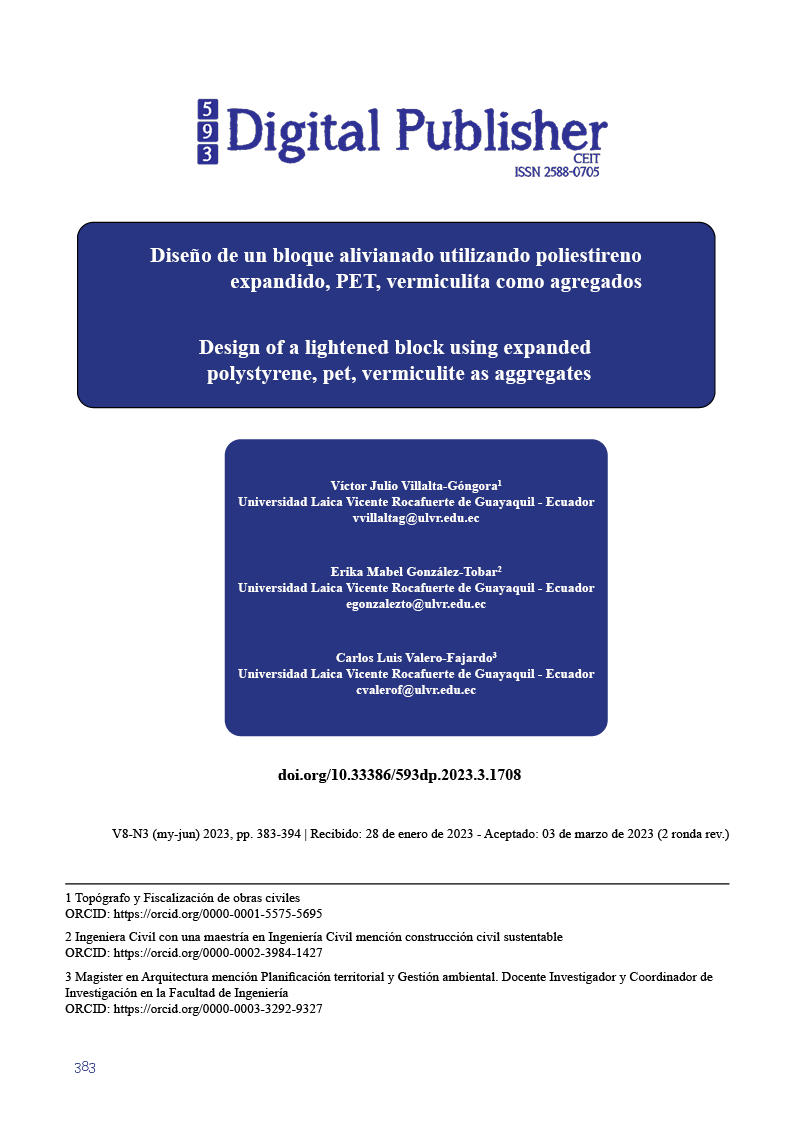Diseño de un bloque alivianado utilizando poliestireno expandido, PET, vermiculita como agregados
Main Article Content
Abstract
In recent years, the use of recyclable waste has been gaining ground in the field of construction, since the generated waste can be revalued and reduce the impacts that this waste can cause in the environment, without reducing the quality of the constructions. For this reason, the present research work has the objective of designing a lightened block by adding expanded polystyrene, PET, vermiculite to the mortar mixture to differentiate cost-benefit from the traditional market, applying an experimental methodology with a quantitative approach, since it was developed tests to determine the adequate dosage for lightened blocks, and tests of simple compression, absorption, and bibliographic analysis of shrinkage tests by linear drying, visual aspects and marks and resistance to fire. Four tests were carried out on blocks with different dosages, of which the fourth test was optimal for lightened blocks with a dosage of 20% expanded polystyrene, PET, vermiculite. In addition, modulus of rupture values of 9.57 MPa, 9.53 MPa and 9.48 MPa were obtained, in the maximum time of 28 days, the economic and environmental analysis was carried out in comparison with a traditional block. It is concluded that, based on the results, the dosage of block No. 4 is adequate for the elaboration of the lightened blocks, since the tests show that they are within the requirements of the Ecuadorian Construction Standard.
Downloads
Article Details

This work is licensed under a Creative Commons Attribution-NonCommercial-ShareAlike 4.0 International License.
1. Derechos de autor
Las obras que se publican en 593 Digital Publisher CEIT están sujetas a los siguientes términos:
1.1. 593 Digital Publisher CEIT, conserva los derechos patrimoniales (copyright) de las obras publicadas, favorece y permite la reutilización de las mismas bajo la licencia Licencia Creative Commons 4.0 de Reconocimiento-NoComercial-CompartirIgual 4.0, por lo cual se pueden copiar, usar, difundir, transmitir y exponer públicamente, siempre que:
1.1.a. Se cite la autoría y fuente original de su publicación (revista, editorial, URL).
1.1.b. No se usen para fines comerciales u onerosos.
1.1.c. Se mencione la existencia y especificaciones de esta licencia de uso.
References
ACI318S-14. (2015). Institute, American Concret.
Anónimo. (2019). Dosificacion de Hormigon. https://ocw.unican.es/pluginfile.php/811/course/section/869/Dosificacion%20de%20Hormigones.pdf
ASTM. (2014). ASTM C330-04.
ASTM. (2019). American society for Testing and materials.
Behar, D. (2008). Introducción a la Metodología de la Investigación. Bogotá: Editorial Shalom.
Briones, M. M. (2019). Recursos Naturales.
Canet, J. M. (2020). Resistencia de Materiales y Estructuras.
Catedra de Ingenieria Rural. (2019). Catedra de Ingenieria Rural.
Chamalé , J. (2018). Fabricación y evaluación experimental de unidades de mampostería de concreto celular de espuma preformada.
Civil. (2019). Modulo de Finura de Agregados.
Construcción, A. Y. (2019). https://www.interempresas.net/Construccion/Articulos/37082-Los-aridos.html
Díaz, J., & Torres, H. (2018). Evaluación técnica de bloques de concreto para uso estructural elaborados de escombros de concreto de losas de pavimento rígido .[Tesis de grado, Universidad Nacional Toribio Rodríguez de Mendoza de Amazonas].
Diccionario de la lengia Española. (2019).
Ecosiglos. (2018). Ecosiglos. https://ecosiglos.com/que-es-el-poliestireno-expandido-y-como-tratarlo/
ECURED. (2020). Granulometria. Ecured. https://www.ecured.cu/Granulometr%C3%ADa
Enseñanza, F. d. (2019). Tipos De Esfuerzos Fisicos. https://www.feandalucia.ccoo.es/docu/p5sd8567.pdf
Gareca, M., & Andrade, M. P. (2020). Nuevo material sustentable: ladrillos ecológicos a base de residuos inorgánicos. Revista Ciencia. Tecnología e Innovación. 18(21), 25-61.
Guevara, G. (2019). Efecto de la variacion agua/cemento en el concreto.
Helene, P. (2019). Materiales reciclados con plasticos para viviendas interes social.
Hernández, A. V. (2019). Fabricacion de bloques con residuos plasticos.
Hernandez, F. &. (2017). Metodologia de la investigación.
Hernández, R., Fernández, C., y Baptista, P. (2014). Metodología de la Investigación. México D.F.: McGRAW-HILL/INTERAMERICANA EDITORES S.A. DE C.V.
Hidalgo, D., y Pujades , L. (2018). Comportamiento no-lineal de estructuras de mampostería de concreto con refuerzo integral. Revista Internacional de Ingeniería de Estructuras. 23(1).
Infante , J., y Valderrama, C. (2019). Análisis Técnico, Económico y Medioambiental de la Fabricación de Bloques de Hormigón con Polietileno Tereftalato Reciclado (PET). Información tecnológica. 30(5), 25-36.
Leon, M. P. (2020). Scielo. https://www.scielo.cl/scielo.php?script=sci_arttext&pid=S0718-50732010000200003
Madrid , M., y Frómeta , Y. (2022). Análisis de ciclo de vida en bloques de hormigón: comparación del impacto producido entre bloques tradicionales y con subproductos. Informes de la Construcción. 74(566), e438-e438.
Maria Herrera, G. M. (2019). Manual de construccion de manposteria del concreto.
Ministerio de Desarrollo Urbano y Vivienda. (2016). Norma Ecuatoriana de la Construcción, Peligro Sísmico, diseño sísmo resistente parte 1.
Morales. (2019). Contaminacion en fuentes hidricas.
Pérez García, N., y Garnica Anguas, P. (2017). Evaluación de las propiedades mecánicas del poliestireno expandido. Sanfandila: Instituto Mexicano del Transporte .
Pozo. (2018). Reemplazo de productos artificiales a naturales.
Rafael Dominguez, M. L. (2019). Recursos naturales. https://repositorio.cepal.org/bitstream/handle/11362/44785/1/S1900378_es.pdf
Valero, C. L., Muñoz, G. L., y Reyes, M. A. (2022). Adoquín vehicular de capacidad drenante con concha de manglar: un innovador material de construcción. Polo del Conocimiento, 7(7), 2128-2145. https://polodelconocimiento.com/ojs/index.php/es/article/view/4337/10294#
, I. (2019). Instituto De Normalizacion Ecuatoriana.




